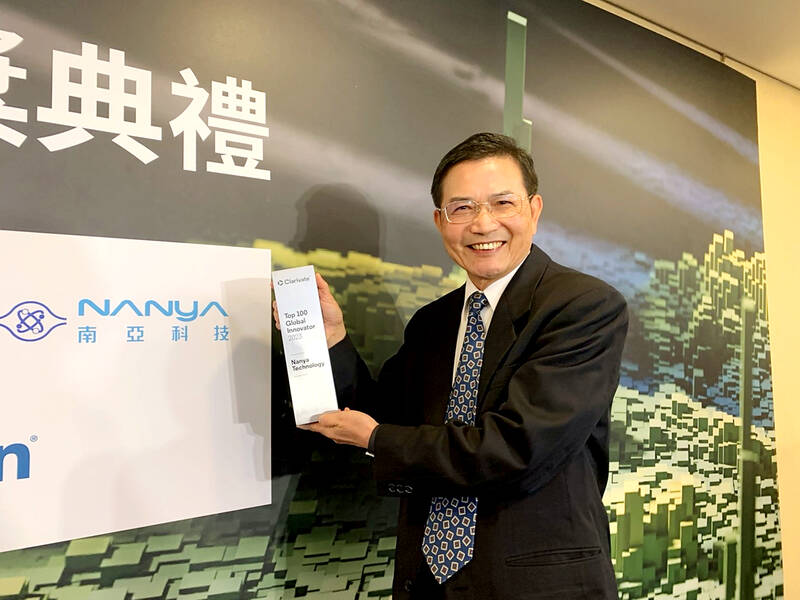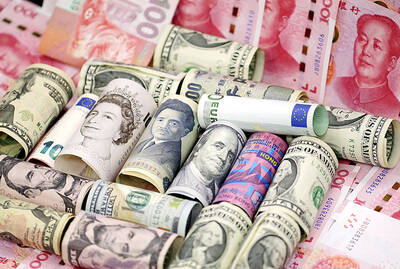DRAM chipmaker Nanya Technology Corp (南亞科技) plans to develop new high-bandwidth memory (HBM) chips tailor-made for edge artificial intelligence (AI) devices such as PCs, mobile phones and robots in an effort to differentiate itself from its rivals.
The HBM3, HBM4 and HBM2 used in AI servers are not the company’s target market, Nanya Technology president Lee Pei-ing (李培瑛) told reporters in Taipei yesterday.
The company’s focus is “customized” HBM products for edge AI devices, given its smaller capacity scale and limited resources, Lee said.

Photo: Grace Hung, Taipei Times
The company plans to roll out its first customized HBM product by the end of next year, in collaboration with chip designer Piecemakers Technology Inc (補丁科技) and chip packaging and testing service provider Formosa Advanced Technologies Co (福懋科技), he said.
Nanya Technology is also teaming up with a logic chip supplier to complete its HBM product, which stacks advanced DRAM chips on a small logic chip. Lee declined to disclose the name of the company’s logic chip partner.
“Under the current market situation, Nanya Technology is unlikely to compete with those chipmakers by capacity, cost efficiency or investment scale, especially those from China. The company needs to differentiate its products and to find its value when the world ushers in the AI era,” Lee said. “Customized HBM products are critical for Nanya Technology’s growth.”
The company aims to boost the contribution of DDR5 chips to about 30 percent of overall DRAM production this year. A majority of its DRAM capacity is for DDR4 chips.
Commenting on competition from a Chinese rival, Lee said the impact is “enormous” for the whole industry, not just on Nanya Technology.
“Without the huge capacity from that Chinese chipmaker, the low-power DDR4 and DDR5 market would have recovered,” he said.
With plentiful capital injection from the Chinese government, China’s Changxin Memory Technologies Inc (長鑫存儲) has become a major memory supplier in the world with capacity seven times bigger than Nanya Technology.
Lee said DRAM demand has improved since China launched new subsidy programs on electronics purchases last quarter.
He said the supply of DRAM chips for non-AI devices is dwindling, as major players such as SK Hynix Inc and Samsung Electronics Co are allocating more capacity for HBM chips used in servers.
Including Micron Technology Inc, the world’s top three producers’ inventory situation is also improving, he added.
These signs are positive for the industry, with a price rebound likely in the second half of this year, he said.
The company’s board of directors yesterday decided not to distribute cash a dividend this year, even though its losses shrank to NT$5.08 billion (US$154.9 million) last year from NT$7.44 billion in 2023.
The board approved capital expenditure of NT$19.6 billion this year to fund capacity buildup for its second-generation 10-nanometer-class process technology, denoting a process between 10-nanometers and 19-nanometers.

Taiwan’s foreign exchange reserves hit a record high at the end of last month, surpassing the US$600 billion mark for the first time, the central bank said yesterday. Last month, the country’s foreign exchange reserves rose US$5.51 billion from a month earlier to reach US$602.94 billion due to an increase in returns from the central bank’s portfolio management, the movement of other foreign currencies in the portfolio against the US dollar and the bank’s efforts to smooth the volatility of the New Taiwan dollar. Department of Foreign Exchange Director-General Eugene Tsai (蔡炯民)said a rate cut cycle launched by the US Federal Reserve

Handset camera lens maker Largan Precision Co (大立光) on Sunday reported a 6.71 percent year-on-year decline in revenue for the third quarter, despite revenue last month hitting the highest level in 11 months. Third-quarter revenue was NT$17.68 billion (US$581.2 million), compared with NT$18.95 billion a year earlier, the company said in a statement. The figure was in line with Yuanta Securities Investment Consulting Co’s (元大投顧) forecast of NT$17.9 billion, but missed the market consensus estimate of NT$18.97 billion. The third-quarter revenue was a 51.44 percent increase from NT$11.67 billion in the second quarter, as the quarter is usually the peak

Nvidia Corp’s major server production partner Hon Hai Precision Industry Co (鴻海精密) reported 10.99 percent year-on-year growth in quarterly sales, signaling healthy demand for artificial intelligence (AI) infrastructure. Revenue totaled NT$2.06 trillion (US$67.72 billion) in the last quarter, in line with analysts’ projections, a company statement said. On a quarterly basis, revenue was up 14.47 percent. Hon Hai’s businesses cover four primary product segments: cloud and networking, smart consumer electronics, computing, and components and other products. Last quarter, “cloud and networking products delivered strong growth, components and other products demonstrated significant growth, while smart consumer electronics and computing products slightly declined,” compared with the

The US government on Wednesday sanctioned more than two dozen companies in China, Turkey and the United Arab Emirates, including offshoots of a US chip firm, accusing the businesses of providing illicit support to Iran’s military or proxies. The US Department of Commerce included two subsidiaries of US-based chip distributor Arrow Electronics Inc (艾睿電子) on its so-called entity list published on the federal register for facilitating purchases by Iran’s proxies of US tech. Arrow spokesman John Hourigan said that the subsidiaries have been operating in full compliance with US export control regulations and his company is discussing with the US Bureau of